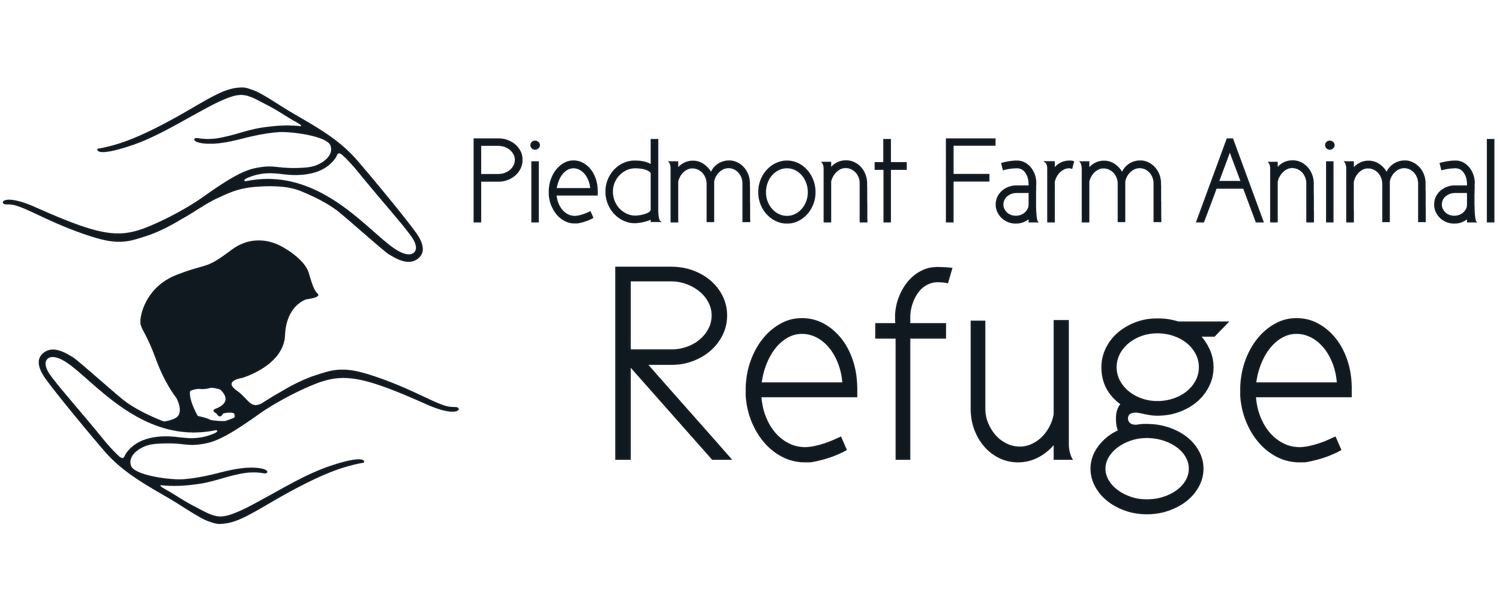Factory Farming: Cows
By Ashish George for Piedmont Farm Animal Refuge
Did you hear about the cow marked for slaughter who escaped from captivity and made a run for it? No, not the cow in Queens, New York who eventually got a second chance at a sanctuary and the new moniker “Freddie”, an apt choice considering his namesake’s famous cry in one of his hit songs that he wanted to break free. No, not that other defiant cow in Queens who chose liberty but ultimately wasn’t as fortunate as Freddie. No, not Bonnie the photogenic four-month-old calf whose odyssey included eight months in the woods with a welcoming herd of deer until she was rescued by compassionate people. The cases add up, and it’s hard to keep track of them all. What’s not hard to keep track of, however, is the truth behind these jailbreaks: cows value their lives, but factory farming doesn’t value cows.
The myth of the small American farmer waking up at dawn to milk his cows and lavish them with affection is an artifact of the beef and dairy industry’s public relations campaigns. Seven out of ten cows live on factory farms, which deprive them of room to move around and sanitary conditions. Since cows, like humans, are mammals, they don’t produce milk unless they are pregnant or were recently pregnant. Dairy cows on factory farms are impregnated every year, and their calves are taken away hours after they are born because the milk that would normally be shared between mother and child is destined for the supermarket. Artificial insemination is the preferred method of getting cows pregnant. The details are grim. A gloved hand and arm apply downward pressure on the rectum. This results in the opening of the cow’s vulva, which allows for the insertion of a long catheter headed for the cervix. As the catheter approaches the cervix, the hand in the rectum takes hold of the cervix and adjusts it so that the catheter can enter. Needless to say the cow can’t object. Most factory farms don’t even bother having a veterinarian handle the chore. Staff at the farm with varying degrees of knowledge of a cow’s body take up this highly exploitative and highly manipulative process. A cow will produce milk for about ten months after giving birth. The cycle soon starts again. Artificial insemination will be used to force the cow into milk production. Dairy cows are slaughtered after about four years. The natural lifespan of a cow is 20 years.
Male calves are not as productive for factory farms because they can’t yield milk. Unsurprisingly, this gives them less time, sometimes as little as a few hours. Many of the ones who are not killed immediately are sent to penned-in feedlots containing up to 150,000 cattle. The goal here is to fatten them up with grain-based diets before slaughter. One in five calves—males as well as females who aren’t needed on dairy farms—might be placed in veal crates. Movement is limited in the crates to keep the muscles undeveloped. The resulting menu item at restaurants is intended to be tender flesh, but all tenderness was denied to the animals in their far too brief existences.
It doesn’t have to be this way. The cows at Piedmont Farm Animal Refuge get to be true to their natures without fear of constant pregnancy or death. Mindy, Bentley, Mandy, and Sprout are members of a family that avoided being torn apart because the person who was in charge of their care in Oklahoma had a change of heart and became a vegetarian. The powerful realization that cows deserve more than what they too often get can come gradually or it can come all at once, but when it arrives its implications for our diets (beef, veal, cheese, milk), clothing (leather, suede), and entertainment (rodeos, bullfighting) are profound.
Our knowledge of what cows are like has expanded significantly. The popular stereotype of drooling, unthinking hamburgers waiting to be shipped off is a mistake. Cows like music, express friendship through grazing and licking, and communicate through unique sounds appropriate for different emotions. Much of the research into cows’ lives is fairly recent, so we should fully expect even more revelations as scientists observe their natural behaviors—natural behaviors frustrated by factory farms—in the years to come.
None of us are perfect, and perfection is a difficult goal in a society with such a long tradition of dismissing the interests of animals. But a visit to Piedmont Farm Animal Refuge can be the first step in your own escape: the escape from habits that cause real, if often unseen, harm. Please consider planning your visit. The cows can’t wait to see you. They’ve traveled a long way.
Resources:
Huemer, Michael. Dialogues on Ethical Vegetarianism. Routledge, 2019.
Cow by Andrea Arnold. IFC Films, 2021.


